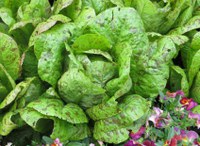Dakota Gardener: Gardening Resolutions for 2022
(Click the image below to view a high-resolution image that can be downloaded)
By Esther E. McGinnis, Horticulturist
NDSU Extension
January is a great time to reflect on the previous year’s gardening successes and failures. This can lead to resolutions to improve gardening practices or to just try something new. To help you in setting resolutions, consider adopting one or more of the following suggestions.
- Try growing a different cultivar of vegetable or herb. If you have always grown ‘Straight Eight’ cucumber, experiment with a slender burpless cucumber called ‘Summer Dance’. You won’t be sorry. Personally, my resolution is to plant an Austrian heirloom lettuce called ‘Flashy Trout Back’. I am enamored of the green leaves with maroon speckles. The plants are so ornamental that it is almost a shame to harvest the leaves.
- Start an herbal tea garden. Teas can be made from herbs such as mint, lemon balm, lavender and chamomile. This is a fun project that can be planted in containers if space is limited.
- If your lawn is looking tough, raise the deck on your lawn mower to 3 inches. Maintaining a taller lawn height is beneficial for its health. A longer grass blade corresponds to a deeper root system which is more drought tolerant. In addition, taller grass can prevent the germination of certain weed seeds.
- Save money by doing fewer lawn herbicide applications. Every year, I see my neighbors spraying their lawn weeds in mid-summer. This is really a waste. Summer lawn applications are the least effective because the weeds are growing vigorously. Spraying in September is the most effective because the weeds are at their most vulnerable.
- Install a rain barrel. Last summer’s drought reminded us how precious water is. Rain barrels are designed to catch rainwater falling on the roof as it exits the downspout. This water can be used to irrigate ornamental gardens and trees.
- Incorporate a native flowering plant or two or three into your ornamental garden. Native plants are more likely to support pollinators such as butterflies and bees. Swamp milkweed (Asclepias incarnata) and meadow blazing star (Liatris ligulistylis) are two beautiful flowering plants that will attract monarchs.
- Consider adding a fall blooming perennial to your landscape. Most people’s landscapes are quite boring in fall. However, if you add an aster, hardy mum or fall blooming anemone to your garden, your neighbors will notice your gardening prowess.
- Teach a child how to garden. Of all the resolutions, this may be the most important. As society has transitioned from rural to urban and suburban life, our children and grandchildren have lost touch with how food is produced. Introduce them to the art and science of gardening. You will be rewarded with kids that are more likely to eat fresh vegetables and to put down their cell phones.
- Keep a garden journal in 2022. How many times have you grown a new vegetable cultivar but forgotten the name by next year? To ensure gardening success in the future, a simple garden journal will allow you to keep track of what worked and what didn’t work.
Happy New Year!
For more information about gardening, contact your local NDSU Extension agent. Find the Extension office for your county at https://www.ndsu.edu/agriculture/extension/county-extension-offices.
NDSU Agriculture Communication - Jan. 4, 2021
Source: Esther McGinnis, 701-231-7971, esther.mcginnis@ndsu.edu
Editor: Kelli Anderson, 701-231-6136, kelli.c.anderson@ndsu.edu


